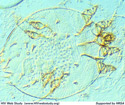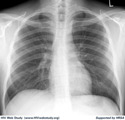
Editor
David H. Spach, MD
Professor of Medicine
Clinical Director, Northwest AETC
Division of Infectious Diseases
University of Washington
Associate Editor
Joel E. Gallant, MD, MPH
Professor of Medicine and Epidemiology
Associate Director, AIDS Service
Division of Infectious Diseases
Johns Hopkins University
![]() NEW!
NEW!
HIV Lifecycle Module: HIV Integration
Welcome to our new animated tutorials section. This tutorial provides an easy-to-understand, in-depth overview of HIV Integration. Free CME.

New Cases
 A
43-Year-Old with a Persistent Skin Rash
A
43-Year-Old with a Persistent Skin Rash
Evaluation of skin rashes can prove very difficult in HIV-infected persons with advanced immunosuppression.
In this case, the diagnosis of these hyperkeratotic, scaling lesions was made on a skin scraping when viewed
under a microscope. Test your skills in diagnosis and management in this challenging unknown.
 Efavirenz-Associated
Central Nervous System Adverse Effects
Efavirenz-Associated
Central Nervous System Adverse Effects
Efavirenz (Sustiva) is one of the most frequently used antiretroviral medications. The concern
for neuropsychiatric adverse effects often plays a role in the decision of whether to include efavirenz
as part of an antiretroviral regimen. This case includes a discussion of available data related to efavirenz-related
neuropsychiatric manifestations. In addition, this case provides practical recommendations for the prevention
and management of these symptoms.
 A
27-Year-Old with Disseminated Histoplasmosis
A
27-Year-Old with Disseminated Histoplasmosis
Disseminated histoplasmosis in HIV-infected persons is a potentially life-threatening infection. Clinical
manifestations are often non-specific. Diagnostic testing often involves using a combination of tests, including
antigen tests and culture. Preferred initial treatment of progressive disseminated infection consists of
liposomal amphotericin B (AmBisome), followed by maintenance therapy with oral itraconazole (Sporanox).
 A
43-Year-Old with New Visual Symptoms
A
43-Year-Old with New Visual Symptoms
Cytomegalovirus retinitis remains an important clinical problem with patients with advance immunosuppression.
Symptoms of cytomegalovirus retinitis usually include one or more of the four “F’s”: floaters, flashes,
field deficits, or failing vision. Oral valganciclovir (Valcyte), with or without a ganciclovir
intraocular implant, is generally recommended for initial therapy.
 African
Americans with HIV: Epidemiology and Risk Factors
African
Americans with HIV: Epidemiology and Risk Factors
The HIV epidemic has disproportionately affected African Americans and in recent years more new diagnoses
of HIV (with or without AIDS) involve African Americans than any other racial/ethnic population. This case
includes a review of the epidemiology and factors related to the explosion of the HIV epidemic in African
Americans.
 Protease
Inhibitor-Associated Hyperbilirubinemia
Protease
Inhibitor-Associated Hyperbilirubinemia
Isolated unconjugated hyperbilirubinemia is a known adverse effect that can develop while taking atazanavir.
This case includes a review of the natural history, mechanism, genetic predisposition, and management of
protease-inhibitor associated hyperbilirubinemia.
Copyright © 2004-2008 University of WashingtonLast Updated: September 9, 2008



